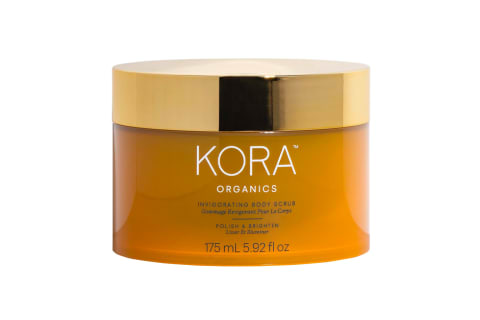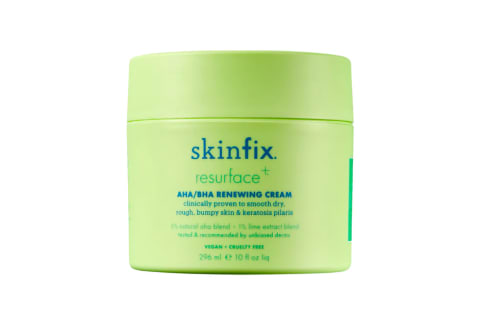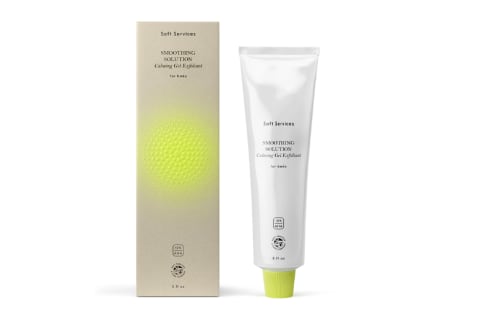So to follow, we created an expert guide to exfoliating your legs—from scrubs to serums to tools and more. Plus, a few reasons you might want to start exfoliating ASAP if you haven’t already. Happy buffing! One perk of using a body scrub is that it’s typically done in the shower (read: extremely low lift). You can keep your favorite store-bought scrub right next to your body wash (a few mbg-approved picks here), or make your own—we’ll share our go-to DIY recipe in a bit. Whether it’s store-bought or homemade, be sure to keep the granules fine. Many formulas use sugar and coffee, but regardless, “It is best to make sure the granules are small and smooth to prevent the scrub from being too abrasive on the skin,” board-certified dermatologist Marisa Garshick, M.D., FAAD, tells mbg. While these scrubs may be beneficial for some, they’re not fit for everyone. “Those with sensitive skin should avoid harsh scrubs and loofahs,” Garshick says. So if you notice your scrub leaves behind redness or irritation, it might be too harsh. Instead, look to chemical exfoliants—up next. You should know that chemical body exfoliators are often way more potent: The skin on the body is thicker than the skin on the face, which is why exfoliating serums generally have a higher percentage of AHAs or BHAs. For general exfoliation, AHAs like glycolic, lactic, and mandelic acid will help to gently dissolve dead skin and brighten tone. Salicylic acid, on the other hand (which is oil-soluble), may help manage body breakouts while exfoliating. Even though ingredients like glycolic acid and lactic acid may sound intimidating, they can actually be a more gentle form of exfoliation than some body scrubs. In fact, for those with keratosis pilaris (KP) or “strawberry legs,” this form is preferred. “In general, mechanical exfoliation is not the best for KP and can even make it worse,” board-certified dermatologist and founder of MaeiMD Rebecca Marcus, M.D., FAAD, tells mbg. More on KP in a bit. If you’re just as concerned about exfoliation as you are easing crepey skin, then a retinol body lotion might be a good addition to your routine. As shown in clinical studies, retinol treatment can stimulate collagen production1 and help decrease the appearance of wrinkling. Just as you would on your face, be sure to isolate your retinol product by using it on different evenings than you do an exfoliating serum or body scrub to avoid irritation. Think of it as skin cycling but for the body. What we do know is that dry brushing is a form of physical exfoliation that can also increase circulation on the skin. However, it’s still up for debate whether you actually need to manually stimulate circulation (some studies show lymph pumps can improve lymphatic function2) or if simply moving your body is enough. Regardless, studies show that improved circulation is better for skin overall—no matter how you get things going. “Dry brushing can be useful as an exfoliating mechanism, but great care must be taken to make sure that the bristles are gentle enough that the skin is not being abraded,” Marcus explains. “Disrupting the skin barrier can lead to increased dryness and do more harm than good.” Just like any form of manual exfoliation, be sure to find a dry brush that works for your skin—again, if your skin gets red and dry afterward, then you should probably switch to something more gentle. Here’s a bit more information about dry brushing, if you’re curious. And if you’re ready to invest, here’s a list of our top picks. You can even use a washcloth in conjunction with an exfoliating body wash or fine-grained scrub if you need some extra power. These mitts are great for targeting smaller areas like the bikini line—but you must remember to wash them and let them air dry every few weeks. If your mitt never fully dries, it might start to collect bacteria and even grow mold. Especially for those who shave their legs or remove hair in general, hyperpigmentation is always a risk. Luckily, exfoliation can help fade dark spots and post-inflammatory hyperpigmentation over time, contributing to more even-looking skin on the legs. And remember: You should always apply a body lotion or body oil after you shower, especially if you’ve just exfoliated. If you’re using retinol body cream, be sure to exfoliate the day before (again, classic skin cycling). This way, the dead skin gets removed and the retinol can perform to its best ability on the skin. “Gentle exfoliation can help [loosen] the free edge of hairs that may be trapped under the skin,” board-certified dermatologist Joshua Zeichner, M.D., once told mbg. “This can give you a smoother shave and lower the likelihood of razor bumps or irritation.” If you’re more prone to breakouts than ingrowns, then opt for a salicylic acid exfoliating serum or body wash, as it’s also anti-inflammatory, antimicrobial, and can penetrate deep into pores. “Exfoliation is one of the key treatments to help with keratosis pilaris, as it is often recommended to use an alpha-hydroxy acid, like glycolic or lactic acid, to help improve skin texture,” Garshick says. During a bout of eczema, dermatitis, or any other sensitizing skin condition, be sure to skip this step as well. Stick to nourishing and simple moisturizers instead. And perhaps this goes without saying, but you shouldn’t exfoliate every single day. The upper limit is twice a week, Marcus says, especially if you’re new to exfoliation. If you want to focus on a smooth shave, then schedule your exfoliation one day prior. See here for more information on an exfoliating cadence. “Gentle exfoliation can help [loosen] the free edge of hairs that may be trapped under the skin,” board-certified dermatologist Joshua Zeichner, M.D. once told mbg. “This can give you a smoother shave and lower the likelihood of razor bumps or irritation.”






